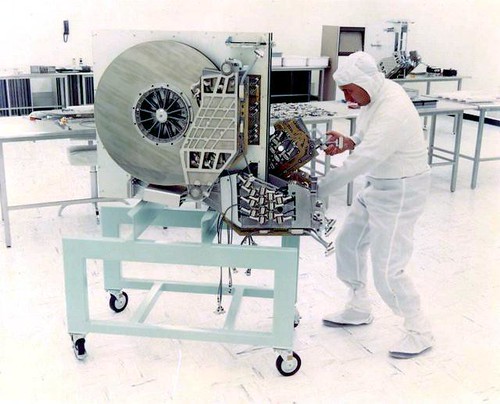
The article referencing the photo is here:
Hard Disk de 1975
Now, to put this in perspective for you non-geeks, 500K is less than the size of a small digital photograph. In 1975, if you wanted to take a photo with a digital camera, you would've needed a truck to haul the thing around, and you'd have been able to take ONE tiny photo. Today, with most digital cameras, with a small memory stick inserted, you can take upward of two hundred high resolution pictures -- many more, if you'd be happy with smaller photos.
In a word: whoa.
Which brings me to the Osborne Portable Computer.

The Osborne was my first real computer, purchased in 1981, and at the time, it was the technological peak of geek civilization. I believe it was the first computer to come bundled with software, including the Wordstar word-processing program (whose control-key combinations we still use today, ie: Control-C for copy, Control-V for paste, etc.), and it cost around $1700. For that $1700 (in 1981 dollars) you got a box that weighed twenty or thirty pounds (portable my ass), that had a 5 inch CRT screen which could only show 52 characters across at a time, and an operating system called CP/M that ran off a floppy disk. The CRT screen was text-only. The computer's memory was 64K. (My G5 Powermac has two gigs of memory installed.) Storage consisted of two 5-inch floppy disk drives. Each floppy could hold about 90K. A screenplay took up two or three floppies.
And it was the coolest thing I'd ever owned.
Before I bought an Osborne, I tried using a Radio Shack TRS-80 computer, but found it little more useful than a toy.

The TRS-80 may have been a great computer, but I never managed to do anything useful with it. For storage, it used ordinary audio cassette tapes. (Apparently floppy disk drives were available but my local Radio Shack must not have known about them.) There were a few programs readily available, mostly text-adventures, but as far as I ever knew, that was about it. Basically, for me, the machine was an oversize paperweight.
The Osborne, however, was a fully functional workhorse, and using it, Roy Thomas and I wrote several screenplays together. It was awkward, though. I had to attach a full-size (13 inch) CRT monitor so we could see the screen, but even a full-size CRT could only display 52 characters across at a time. Since most printed pages ran 80 characters across, the screen had to shift back and forth as you typed a line. Bizarre, but you got used to it. As dinky as it seems today, it was an extremely useful machine for the time, an incredible achievement in innovation.
And like all innovative achievements, the moment it was produced, it was doomed.
Technology doesn't sit still. (Nothing in the world sits still, really, but compared to most of aspects of our lives, technology is a kid with A.D.D. on caffeine.) It evolves constantly. (According to Moore's Law, the capacity of a semiconductor -- the heart and brain of a computer -- doubles even 18 months.) Today's miracle is tomorrow's antique. Literally.
By the time I'd written one screenplay on the Osborne, it was already old technology.
1981, you see, was also the year IBM introduced the PC.
Unlike the Osborne, which had 64K of memory and ran CP/M, the IBM PC had up to 256K of memory and ran MS-DOS. It was sleeker, faster, more powerful, and it was open-source (meaning other companies could easily design compatible products and clone computers using the same specs). In a matter of months it was the dominant computer platform for personal computers. And once IBM was in the market, the market exploded -- prices came down, technology sped up, capacity grew, and before you knew it, the Osborne was obsolete.
There's a lesson here, I guess. I could offer an analogy to political parties, social beliefs, popular culture, and so forth. But I won't. You can draw your own conclusions. Just ask yourself...
What favorite technology, political belief, social belief, or cultural phenomena, is the Osborne of today?
My answer?
All of them.




No comments:
Post a Comment